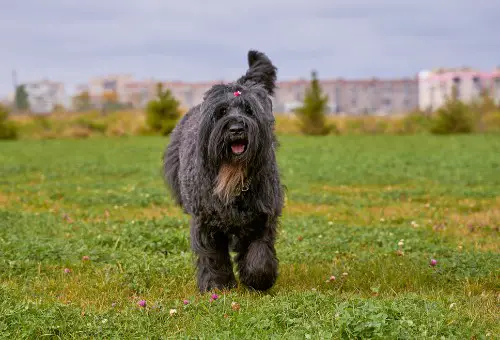The tail wag: is there any behavior that’s more dog-like? Dogs may not be the only animals that wag their tails, but they certainly do it in the most iconic way.
Most people associate tail wagging with happiness and excitement, but there’s far more to it than that. Dogs wag their tails to communicate many different emotions, and it’s not always immediately obvious which one it is.
So why is your dog wagging his tail, and what are some telltale signs for each reason? Here’s your guide to decoding your dog’s tail wagging.
The Tail Wag Dictionary

Happiness
The classic cause of tail wagging is happiness. Happy dogs wag like they have no control over themselves, sometimes swinging their tails so fiercely that their whole rear ends move too!
A happy tail wag communicates to other animals that the dog is feeling friendly, excited, or just plain joyful. It’s often accompanied by a relaxed facial expression, bouncy movements and excitable vocalizations.
The faster the tail wag, the happier the dog. An overjoyed dog may wag his tail so fast that it becomes a blur — when you see that, you know he’s over the moon with joy!
Studies have shown that happy tail wags tend to be oriented to the right. That’s because the right side of the body is controlled by the left side of the brain, where positive emotions like love are controlled.
Anxiety and Insecurity
Nervousness can make anyone behave oddly, your dog included. That odd behavior often includes tail wagging.
Have you ever felt so anxious you start smiling or laughing? Well, nervous tail wagging is the dog equivalent of that vexing behavior — it’s a sign that your dog is feeling insecure or uneasy about something.
You might notice anxious tail wagging when your dog meets a new person or realizes he’s going to the vet. It’s usually accompanied by other signs like wide eyes, shaking and hesitant movements.
Fear
Similarly, fearful tail wagging is surprisingly common. When faced with a scary situation, your dog’s tail may start swinging, and if you don’t look closely, you may mistake it for a sign of happiness.
The difference lies in the rest of your dog’s body language. Cowering, whimpering and pinned-back ears all indicate fear; if you bring your dog closer to the scary thing, his tail may even stop wagging and get tucked between his legs.
Fearful tail wags tend to lean more to the left than happy tail wags. The right side of the brain, which is responsible for negative emotions like fear, controls the left side of the body, so a frightened dog’s left side will be more active than his right.
Aggression
Angry dogs will hold their tails high up in the air and wag them back and forth rapidly. It’s a warning that’s easily mistaken for a welcoming… unless you know what else to look for.
Aggression prompts a dog to stare, snarl, bare his teeth, and stand stiffly. Make the wrong move and he’ll respond with a growl, a lunge, and even more tail wagging.
In this case, tail wagging has a purpose besides visual communication. By holding his tail upright and wagging it, he releases more scent from his anal glands and wafts it around.
The scent acts like a calling card, announcing who your dog is, how big he is, his health, and many other odorous facts. It’s his way of saying, “here’s who you’re messing with… are you sure you want to do that?”
Why Does Tail Wagging Work?

Tail wagging can be tough for us to understand, but other dogs seem to get it just fine. What makes it such an effective method of communication for them?
The answer lies in a dog’s eyes. Dogs have relatively poor vision compared to us — they can’t see fine details, so they can’t pick up on each others’ moods by reading microexpressions like humans do.
But while details are tough for dogs, regular old tails pose no problem. That’s because dogs’ eyes are tuned to detect even the tiniest of movements, making a wagging tail impossible to miss.
In fact, the tail may be the most important visual communication tool in a dog’s arsenal. For proof, you need look no further than tailless dogs.
Dogs without tails seem to know that their ability to communicate is greatly impaired. They tend to be much more cautious when approaching other dogs and may exaggerate their other body language to compensate for the lack of tail talk.
Other dogs may also be hesitant to approach tailless dogs. Without the tail wag to indicate friendliness, apprehension or curiosity, they’d rather not take their chances!
